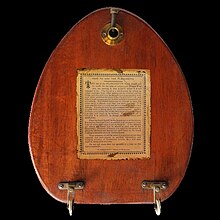
Back لويحة الكتابة Arabic প্লানচেট Bengali/Bangla Planchette (Esoterik) German Planchette French प्लांचेट Hindi Prancheta (espiritualismo) Portuguese 乩板 Chinese 乩板 ZH-YUE

A planchette ( /plɑːnˈʃɛt/ or /plænˈʃɛt/), from the French for "little plank", is a small, usually heart-shaped flat piece of wood equipped with two wheeled casters and a pencil-holding aperture pointing downwards, used to facilitate automatic writing. The use of planchettes to produce mysterious written messages gave rise to the belief that the devices foster communication with spirits as a form of mediumship. The devices were popular in séances during the Victorian era, before their eventual evolution into the simpler, non-writing pointing devices for ouija boards that eclipsed the popularity of their original form. Scientists explain the motion is due to the ideomotor effect,[1][2][3] but paranormal advocates believe the planchette is moved by the presence of spirits or some form of subtle energy.[4]
Planchettes took on a variety of forms during the height of their popularity. American planchettes were traditionally heart- or shield-shaped, but manufacturers produced a wide range of shapes and sizes hoping to distinguish themselves in the highly competitive and profitable market of the devices' late-1860s heyday. Manufacturers espoused the wonders and benefits of different materials (including various hardwoods, India rubber, and even glass), insulated casters, and various attachments meant to "charge" the devices or insulate the user from malevolent spirits.[5] In Great Britain, planchettes took on the classical shapes popularized in early illustrations and newspaper depictions, with round, blunt noses and flat backs. Regardless of their shape or country of origin, almost all planchettes were equipped with brass casters and small wheels of bone or plastic, and their sometimes lavishly illustrated boxes were often packed with blank parchment, pencils, ouija-like folding letter sheets, and esoteric instructions espousing the mysterious communicative powers of the items.[6]
Though planchettes experienced great surges of popularity in Victorian times, in modern usage the term is most commonly associated with the heart-shaped pointers for Ouija or "talking boards". Rather than writing, these devices "dictate" messages by pointing to the board's printed letters and numbers. As writing planchettes were popularized during the beginning of the spiritualist movement of the mid-19th century, planchettes predate the popularization of talking boards by nearly four decades.
- ^ Burgess, Cheryl A; Irving Kirsch; Howard Shane; Kristen L. Niederauer; Steven M. Graham; Alyson Bacon (1998). "Facilitated Communication as an Ideomotor Response". Psychological Science. 9 (1). Blackwell Publishing: 71. doi:10.1111/1467-9280.00013. JSTOR 40063250. S2CID 145631775.
- ^ Sandra Blakeslee; Stephen L. Macknik; Susana Martinez-Conde (2011). Sleights of Mind: What the neuroscience of magic reveals about our brains. Profile Books. pp. 203–. ISBN 978-1-84765-295-9.
- ^ "What is Planchette?". Scientific American. 19 (2): 17–18. 1868. doi:10.1038/scientificamerican07081868-17a. ISSN 0036-8733. JSTOR 26028508.
- ^ Robert Todd Carroll. "Skeptic's Dictionary: Energy". Skepdic.
- ^ "American Planchette Gallery". Retrieved 16 January 2012.
- ^ "British Planchette Gallery". Retrieved 16 January 2012.
© MMXXIII Rich X Search. We shall prevail. All rights reserved. Rich X Search